Trigger types
A comprehensive description of trigger types and their parameters
Every trigger type has an optional priority field. If a user's intent matches the trigger settings of two or more flows, the flow with the highest priority intent will be launched.
regex
Trigger the flow when the user's text input matches the regular expression. We recommend you use pythex to test your regular expressions.
Property | Description | Required | Default |
|---|---|---|---|
| The regex pattern to match. | Yes | |
| Ignore the case of the message. | No |
|
| Store the user's entire input, not just the portion that matched the regex pattern. If | No |
|
Example
Create a new flow and copy-paste the following code into it.
states:
start:
component: meya.text
properties:
text: |
flow.value == {{ flow.value }}
flow.my_num == {{ flow.my_num }}In the Trigger settings, choose the regex trigger type and enter the following pattern: (?P<my_num>\b[1-9][0-9]?\b). Leave the other settings at their defaults and click OK, then Save.
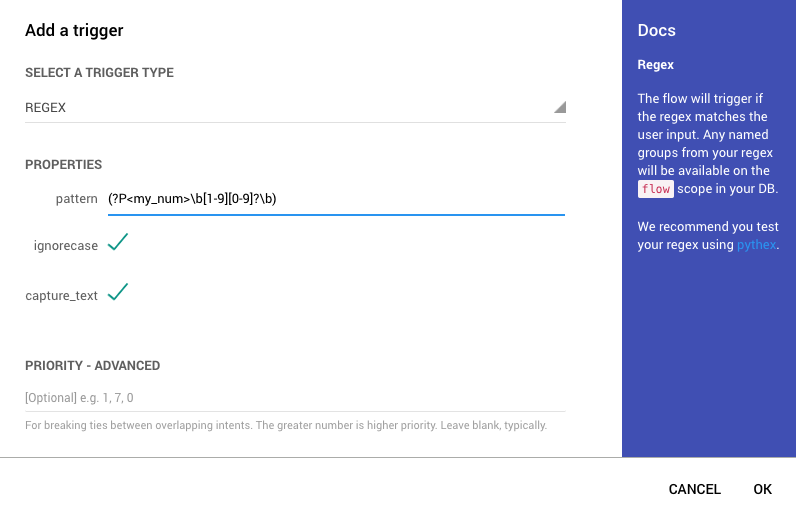
This flow will be triggered when someone enters a number between 0 and 100, even if that number is embedded in a string. The user's entire input is stored in flow.value, while the regex group named my_num is stored in flow.my_num.
Test it in the test chat window:
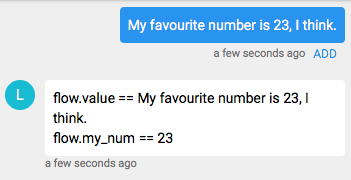
Testing the regex intent.
keyword
Trigger the flow when the user's input exactly matches the keyword.
This trigger can be handy when testing and debugging your bot. For example, you may have hidden flows that print information pertinent only to developers. You can restrict access by using the keyword trigger type with a hard to guess keyword, like t3St1ng.
In general, forcing users to guess the exact word or phrase that will trigger their intended flow creates a bad user experience. Use Natural Language Understanding when possible.
Property | Description | Required | Default |
|---|---|---|---|
| The exact text the input must match. | Yes | |
| Ignore the case of the message. | No |
|
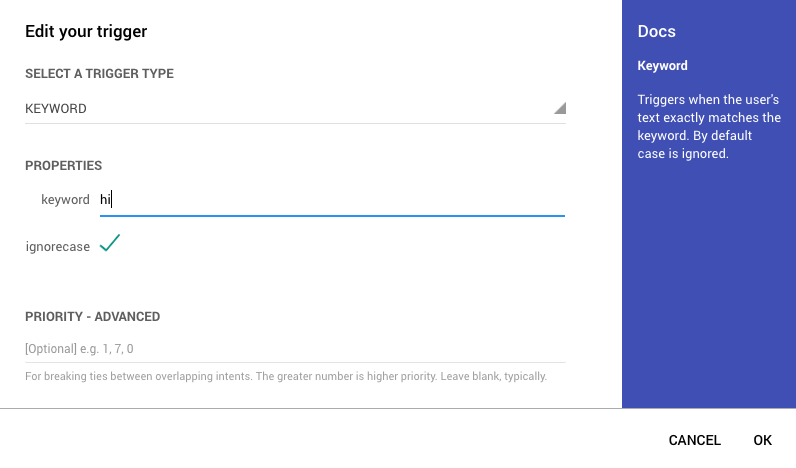
The keyword intent.
dialogflow
Uses third party NLU service Dialogflow to determine the user's intent and trigger the flow if a matching intent is found.
This trigger requires a Dialogflow v2 agent and the Dialogflow integration enabled. If you are using a v1 agent, upgrade your agent or use theapi_aitrigger.
Property | Description | Required | Note |
|---|---|---|---|
| Found in your Dialogflow agent's settings. | Yes | Each agent requires its own Google Project. |
| A 2-letter ISO 639-1 language code your Dialogflow agent supports. | No | Default: autodetect |
| The name of the intent to match. | No | |
| A regular expression to use to match incoming intent. | No | |
| The maximum confidence between | No | Default: |
| The minimum confidence between | No | Default: |
| The number of seconds a request is cached. Set to | No | Default: |
Data available in the flow scope
You can access details regarding the matched intent within within the flow scope.
Parameter | Description |
|---|---|
| The agent's confidence in the match. |
| The intent the agent matched. |
| The user's original text. |
| The agent's response, if you've provided the agent with responses, is located in |
| A simplified version of the query is available in |
| The source agent or domain. |
api_ai
Uses third party NLU service Dialogflow (formerly known as API.AI), to determine the user's intent and trigger the flow if a matching intent is found.
This trigger does not support Dialogflow v2 features, such as multi-language agents. If you wish to make use of those features, use thedialogflowtrigger with your v2 agent.
Property | Description | Required | Note |
|---|---|---|---|
| Found in your api.ai agent settings. | Yes | |
| The 2-letter ISO 639-1 language code of your model. | No | ex. |
| The name of the intent to match. | No | Matches any intent. |
| A regular expression to use to match incoming intent. | No | Used for advanced intent matching. Overrides |
| The minimum confidence between | No | Default: |
| The maximum confidence between | No | Default: |
| The number of seconds a request is cached. Set to | No | Default: |
Example
In DialogFlow, create a new agent and set the language to English. Create two intents, cancel and subscribe. Give each intent 3-5 training phrases and test them out.
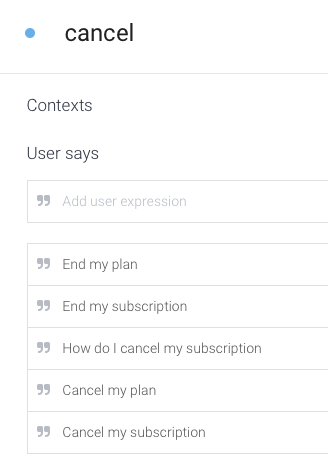
The cancel intent in DialogFlow.
In your agent's settings, note your client access token.

The agent's client access token.
Back in Bot Studio, create a new flow and copy-paste the code below.
states:
start:
component: meya.text
properties:
text: You triggered this flow!For the Trigger type, select api_ai and paste your client access token. Enter en as the agent's language. Leave the other fields with their default values, click OK, then Save.
Test the flow in the test chat window:
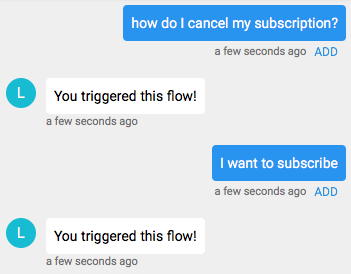
Testing the api_ai intent type.
Note either Dialogflow intent will trigger the flow. This is because we didn't specify which Dialogflow intent we wanted to match. This is important to do since we may want to use the same NLU agent to trigger a cancel_subscription flow as well as a create_subscription flow.
Open the Trigger window again and enter cancel in the intent field. Click OK, then Save. Now test the the flow again.

Testing the api_ai intent type.
This time, only the cancel intent will trigger the flow. The debug console confirms that start a new subscription didn't match.

Data available in the flow scope
You can access details regarding the matched intent within within the flow scope.
Parameter | Description |
|---|---|
| The agent's confidence of the match. |
| The intent the agent matched. |
| The user's original text. |
| The agent's response, if you've provided the agent with responses, is located in |
| A simplified version of the query is available in |
| The source agent or domain. |
wit
Uses third party NLU service Wit.ai to determine the user's intent and trigger the flow if a matching trigger is found.
Property | Description | Required | Default |
|---|---|---|---|
| the wit.ai access token | Yes | |
| the name of the wit.ai intent to match | No | Matches any intent. |
| A regular expression to use to match incoming intent | No | Used for advanced intent matching. Overrides |
| the minimum wit confidence between | No |
|
| the maximum wit confidence between | No |
|
| The number of seconds a request is cached. Set to | No |
|
token: XXXXXXXXXXXXXXXXXXXXXXXXXXXXXXX
intent: book_appointment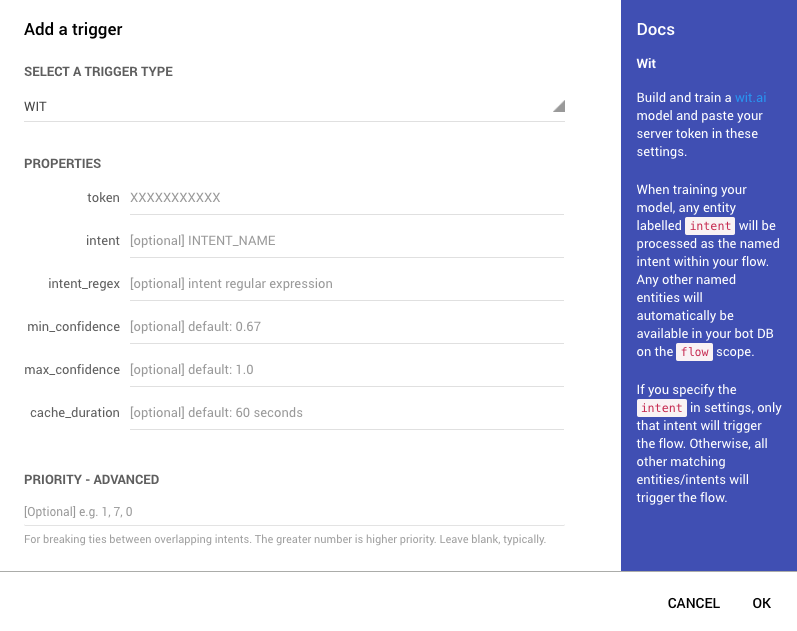
wit.ai
EntitiesMatched entities will be available on
flowscope using the entity name and also as a list by appending_list. For example the uttrance, "I love apples, pears and bananas." would result in the following flow scope data.{ "intent": "fruits" "fruit": "apples", "fruit_list": ["apples", "pears", "bananas"] }
Data available in the flow scope
You can access details regarding the matched intent within within the flow scope.
Parameter | Description |
|---|---|
| The agent's confidence of the match. |
| The intent the agent matched. |
| The user's original text. |
| The agent's response, if you've provided the agent with responses, is located in |
| A simplified version of the query is available in |
| The source agent or domain. |
luis
Matches an intent hosted on third party service luis.ai. Create an account and host your intents and Meya will make API calls.
Example
Create an app on luis.ai.
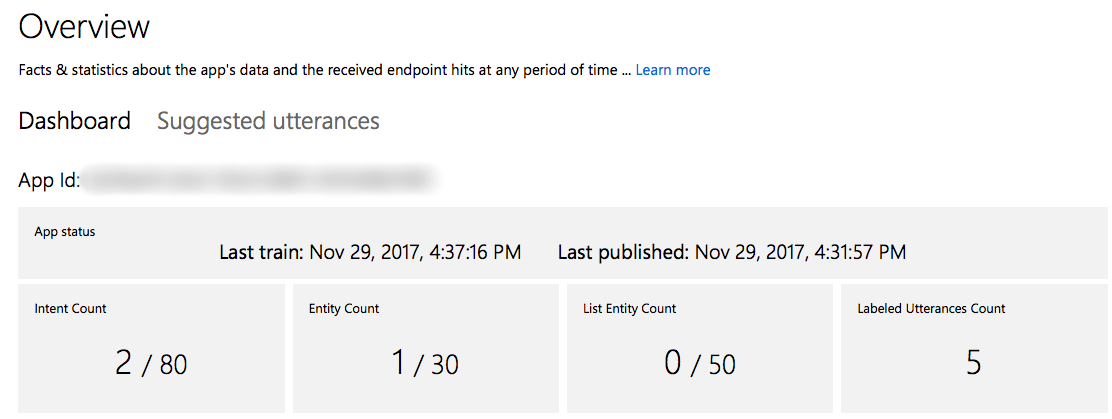
Property | Description | Required | Notes |
|---|---|---|---|
| Found in luis.ai app | Yes | |
| Found in luis.ai app | Yes | |
| the name of the luis.ai intent to match | No | Matches any intent. |
| A regular expression to use to match incoming intent | No | Used for advanced intent matching. Overrides |
| the minimum wit confidence between | No | Default: 0.667 |
| the maximum wit confidence between | No | Default: 1.0 |
| The number of seconds a request is cached. Set to | No |
|
app_id: xxxxxxxxxxxxxxxxxxxxxxxxx
api_key: xxxxxxxxxxxxxxxxxxxxxxxx
intent: order_pizza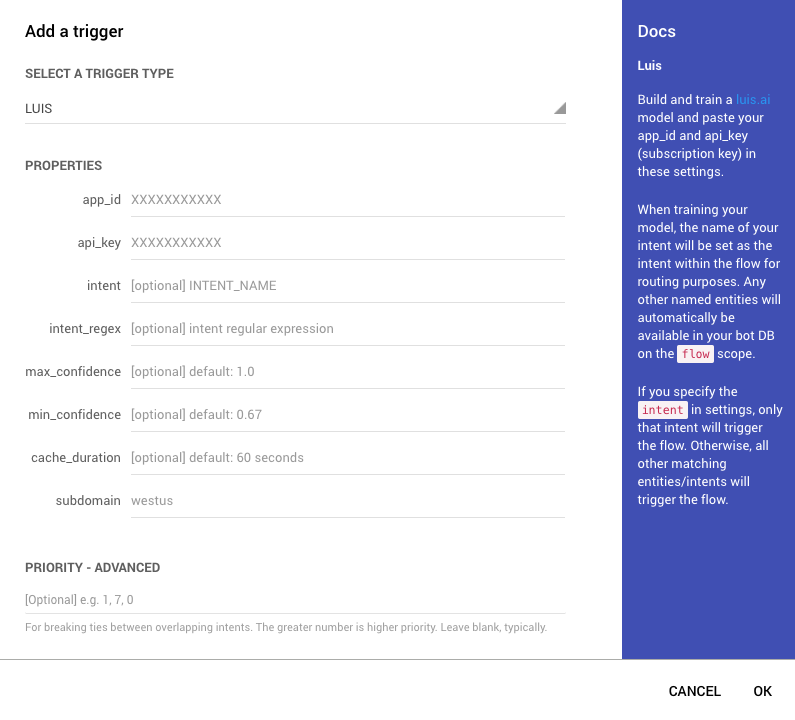
EntitiesMatched entities will be available on
flowscope using the entity name and also as a list by appending_list. For example the uttrance, "I love apples, pears and bananas." would result in the following flow scope data.{ "intent": "fruits" "fruit": "apples", "fruit_list": ["apples", "pears", "bananas"] }
Data available in the flow scope
You can access details regarding the matched intent within within the flow scope.
Parameter | Description |
|---|---|
| The agent's confidence of the match. |
| The intent the agent matched. |
| The user's original text. |
| The agent's response, if you've provided the agent with responses, is located in |
| A simplified version of the query is available in |
| The source agent or domain. |
cms_nlu
If you've trained an NLU agent using Bot CMS, you can use the cms_nlu trigger to handle intents returned by whichever NLU provider is connected to the CMS space.

Property | Description | |
|---|---|---|
| The name of a CMS space. | Required |
| A particular key within the | Optional |
| A language code. | Optional. Default: |
| The minimum confidence required in order to trigger the flow. | Optional. Default: |
| If checked, attempt to determine the user's language and save it to | Optional. Default: |
| If no match is found using NLU, use a basic keyword matching approach instead. | Optional. Default: |
| Previous responses from the NLU agent are cached for | Optional. Default: |
greetings
Greetings is a pre-trained NLP model (in English only) that can be used for your flows.
Intents
- hi
- how_are_you
- help
- whats_up
Example flow using the greetings trigger and auto routing.
route: true
states:
hi:
component: meya.random_text
properties:
responses:
- "Hey there! 😀"
- "Hi! 😃"
- "Howdy! 😃"
- "Hello! 😃"
return: true
how_are_you:
component: meya.random_text
properties:
responses:
- "I'm fine, thanks for asking 😃"
- Great! How are you?
- Super duper. You?
return: true
whats_up:
component: meya.text
properties:
text: Not much. What's up with you?
return: true
help:
component: meya.text
properties:
text: "Happy to help 😃"
return: truecatchall
A catchall trigger will launch the flow whenever a user says something that hasn't matched to any of your other triggers. A flow triggered by the catchall trigger can be used to activate a fallback conversation flow.
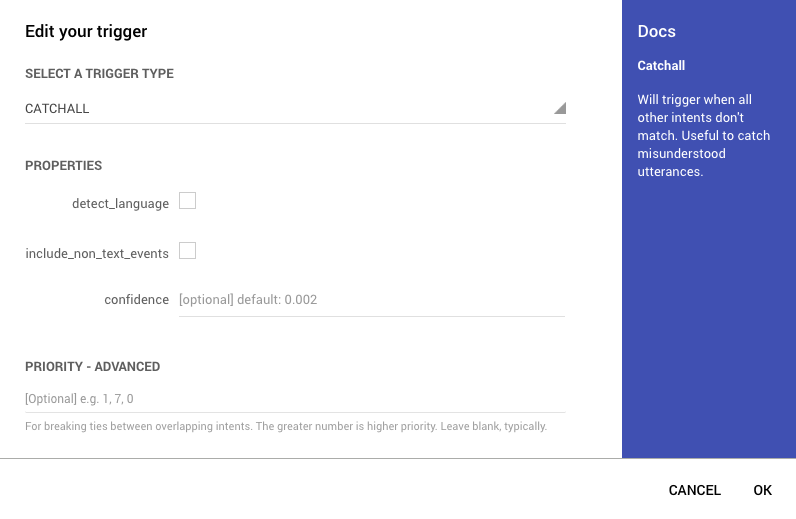
Property | Description | |
|---|---|---|
| If checked, will set | Optional. Default: |
| The default By setting the | Optional. Default: |
| If checked, non-text user input will match the | Optional. Default: |
Example - Detect Language
You can use the catchall trigger to detect a user's language. Start by creating a new flow language. Paste the following code into the flow.
states:
first:
component: meya.text
properties:
text: "Your language is {{ flow.language }}"The above code results in the following behaviour. Note that in the first interaction detect_language is set to false, while in the following three interactions it was set to true.
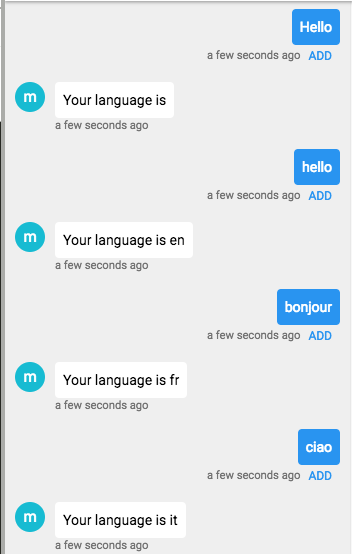
Tip: use a catchall trigger in your customer service bot and then transfer the request to a live agent using the human.transfer component as the first state of your flow.
start_chat
Triggers when someone opens the Meya Web chat for the first time. Checks to see if the user has opened the chat before by referencing the specified key. Optionally only fires on a URL specified in the settings.

The start_chat trigger settings.
Flow scope data
By default, the start_chat trigger populates some flow scope data, if available. If you want this data to persist beyond the current flow, use meya.set, or a Python component, to save the data to the user scope. Data on the flow scope expires once the flow is complete.
Property | Description |
|---|---|
| The URL of the page from which the user is currently accessing the bot. |
| A string identifying the user's web browser and operating system. |
| The URL of the page the user was at immediately prior to coming to the current page. |
| The user's location based on their IP address. Includes |
| A string containing one or more language tags (sometimes referred to as a "locale identifiers") which are set by the user's browser in the The string may also include a For more information, refer to the MDN web docs. |
Here is a simple component that saves each of the above properties to the user scope. The second tab demonstrates how to use the component in a flow.
# -*- coding: utf-8 -*-
from meya import Component
class Save(Component):
def start(self):
for key in ["current_page_url", "user_agent", "referrer", "location", "browser_language"]:
value = self.db.flow.get(key)
self.db.user.set(key, value or "")
return self.respond(message=None, action="next")states:
save_data:
component: save_dataopen_chat
Triggers anytime someone opens the Meya Web chat. Optionally only fires on a URL specified in the settings.
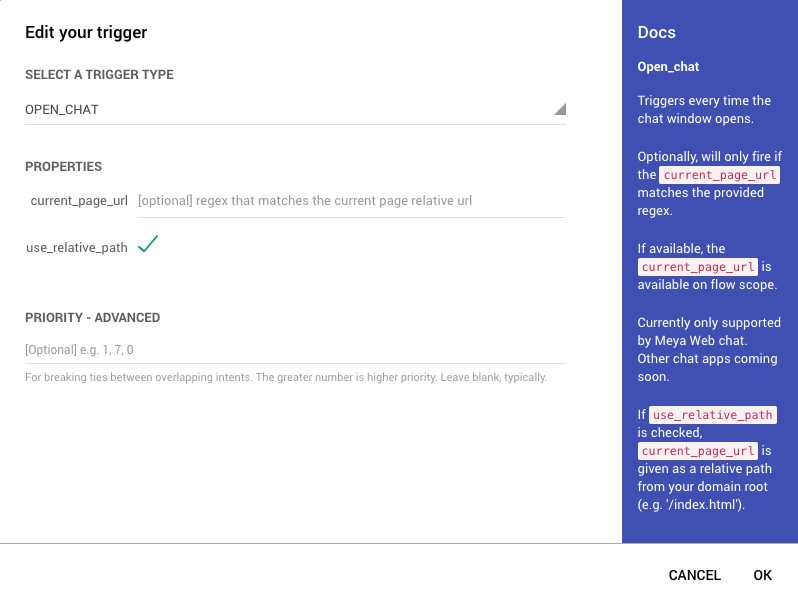
The open_chat trigger settings.
Flow scope data
By default, the open_chat trigger populates some flow scope data, if available. If you want this data to persist beyond the current flow, use meya.set, or a Python component, to save the data to the user scope. Data on the flow scope expires once the flow is complete.
Property | Description |
|---|---|
| The URL of the page from which the user is currently accessing the bot. |
| A string identifying the user's web browser and operating system. |
| The URL of the page the user was at immediately prior to coming to the current page. |
| The user's location based on their IP address. Includes |
| A string containing one or more language tags (sometimes referred to as a "locale identifiers") which are set by the user's browser in the The string may also include a For more information, refer to the MDN web docs. |
Here is a simple component that saves each of the above properties to the user scope. The second tab demonstrates how to use the component in a flow.
# -*- coding: utf-8 -*-
from meya import Component
class Save(Component):
def start(self):
for key in ["current_page_url", "user_agent", "referrer", "location", "browser_language"]:
value = self.db.flow.get(key)
self.db.user.set(key, value or "")
return self.respond(message=None, action="next")states:
save_data:
component: save_data
TipUse the
open_chatevent to keep track of what web page the user is on. Pro tip: Use custom query params to trigger different flows.
start_voice_chat
Triggers every time a voice chat start without a specific invocation.
Integration supportSupported with Actions on Google
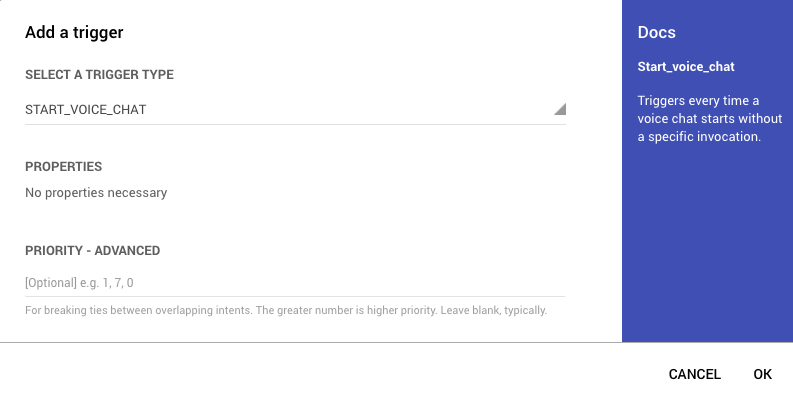
image
Triggers when someone enters an image. The image URL becomes available in flow.value
Integration supportSupported on Messenger, Telegram, Twilio, Kik, Smooch and API & Webhook.
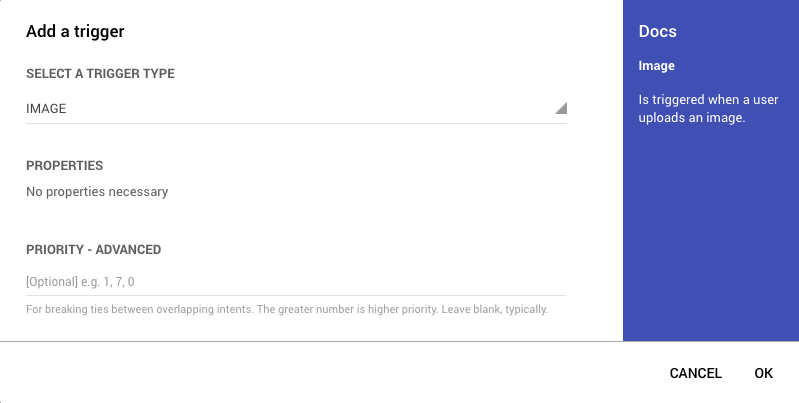
video
Triggers when someone enters a video.
Integration supportSupported on Messenger, Telegram, Kik, Twilio and API & Webhook.
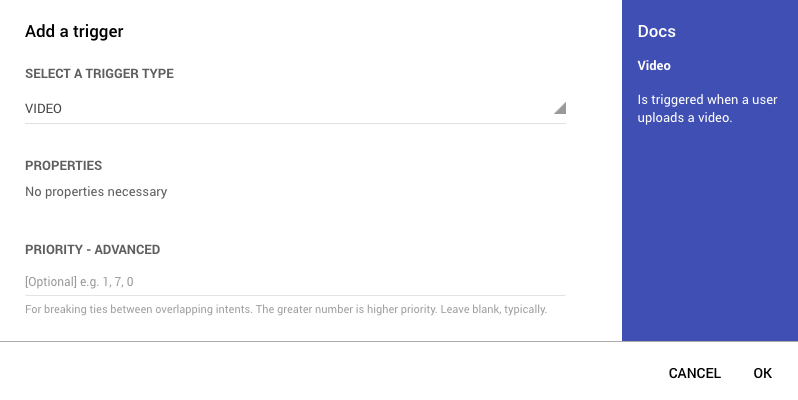
audio
Triggers when someone uploads an audio file.
Integration supportSupported on Messenger, Twilio, Telegram and API & Webhook. Telegram also supports a voice recorded message.
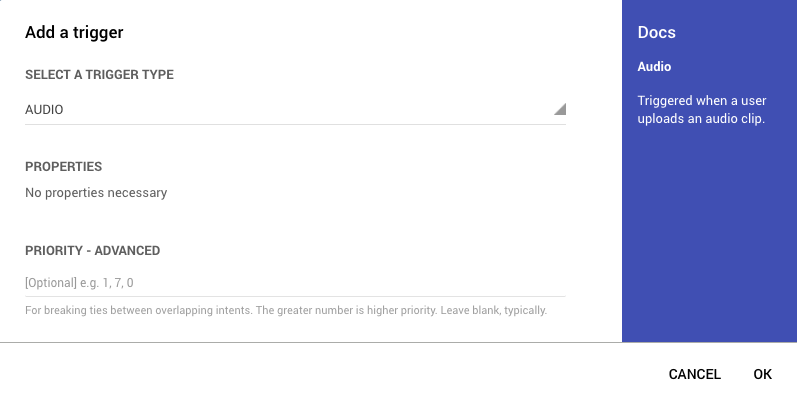
file
Triggers when someone uploads a file.
Integration supportSupported on Messenger, Twilio, Telegram and API & Webhook.

location
Triggers when someone enters their location 📍.
Integration supportSupported on Messenger, Telegram, Smooch and API & Webhook.
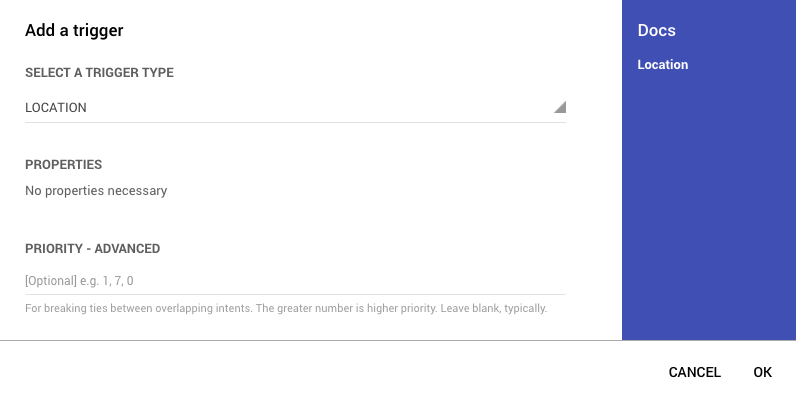
Updated 7 months ago
